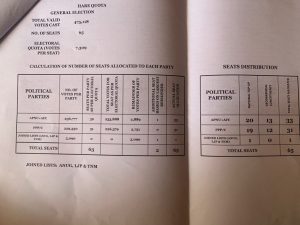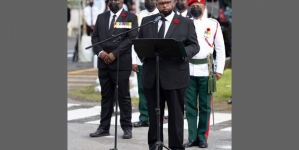How the GECOM CEO unilaterally made votes appear and disappear
Lowenfield, The Conjurer:
Guyana’s Chief Elections Officer (CEO), Keith Lowenfield may be remembered in history as “The Conjurer” for his act of conjuring thousands of ghost votes and unlawfully subtracting thousands of valid votes all with the aim of granting a false win of the March 2, 2020 Elections to the A Partnership For National Unity + Alliance For Change (APNU+AFC) Coalition.
Prior to the national vote recount, Lowenfield sought to present on two occasions, reports to the Guyana Elections Commission (GECOM), which included patently false results, where Region Four was concerned.
Then, following the recount, though he is statutorily mandated to adhere to the directives of the GECOM and its Chair, Retired Justice Claudette Singh, on three consecutive occasions, Lowenfield disregarded direct orders and produced three official ‘final’ election reports using falsified figures.
The CEO
Keith Lowenfield, a former Army official, was unanimously appointed to his post back in March of 2014, replacing the previous CEO, Gocool Boodoo. On his appointment, both the then People’s Progressive Party Civic (PPP/C) government and then opposition APNU+AFC showed full support and confidence in the new CEO.
An article done by Kaieteur News on Lowenfield’s appointment in 2014 had quoted the then major parliamentary opposition party as saying that, “APNU is confident that during Mr. Lowenfield’s tenure as Chief Elections Officer there will be non-controversial and properly administered elections.”

The CEO’s duties
The duties of the CEO are captured in the Representation of the People Act (ROPA) 1:03.
The CEO controls the GECOM Secretariat and acts as the primary point of contact between the Commission and the staff members of the Secretariat, whose activities include the registration of registrants; the distribution of ID Cards; and the provision of information and guidance on electoral operational matters to community organisations and other stakeholders.
Moreover, at the end of every electoral process, the CEO, as statutorily obligated under Section 96 of the ROPA, has to complete a simple calculation of fixed figures to determine the number of votes cast in totality, the total number of valid votes for each party that contested the election and most importantly, the allocation of parliamentary seats. That calculation is then given in the form of a report to the Chair and Commissioners, as spelt out in Article 177 (2) (b) of the Constitution.
This article states that “Where – there are two or more Presidential candidates, if more votes are cast in favour of the list in which a person is designated as Presidential candidate than in favour of any other list, that Presidential candidate shall be deemed to be elected as President and shall be so declared by the Chairman of the Elections Commission acting only in accordance with the advice of the Chief Election Officer, after such advice has been tendered to the Elections Commission at a duly summoned meeting.”
Neither the Constitution nor the Election Laws make any provisions for Lowenfield to subtract and add votes at his will but Lowenfield adopted this task for the March 2, 2020 Elections.

Lowenfield and Mingo
A mere five days after the March 2 Elections, the CEO cemented his role in the attempt to rig the elections after he announced plans to prepare his final report using fraudulent figures that were declared on March 5. Following the controversial declaration made by District Four Returning Officer, Clairmont Mingo, Lowenfield had written to the Commission, signaling his readiness to prepare his report using those very false figures.
“In accordance with Cap 1: 03 Section 99, I have prepared the final report for submission to the Commission. In this regard, a request is made for a meeting of the Commission at your earliest convenience,” the CEO had said in an email to the Chair and six-member Commission.
This is despite there being extensive controversy over whether the results had been verified and tabulated in the presence of all of the entitled officials as specified under the law. That meeting however, was never convened as Opposition Commissioners refused to present themselves, following which Mingo was taken before the High Court.
The High Court had scrapped his initial fraudulent numbers, as he did not follow the legal procedures necessary for the tabulation process. The CEO got his chance to include a new set of fraudulent figures after another declaration was made by Mingo, in defiance of the court order to clearly display the tabulation process being used. A new declaration was made on March 13 and Lowenfield then compiled what he purported to be his final election report including those numbers.
Both reports sought to hand a false victory to the APNU+AFC coalition using what have now been proven to be inflated figures. Because of the controversy surrounding this declaration, a national recount was agreed upon and executed, and the March 13 declaration was placed in abeyance.
Lowenfield’s conjuring
The CEO was ordered at the conclusion of the CARICOM-scrutinised recount to provide the Commission with a summation of the Observation Reports garnered and his final report to make way for a declaration under Section 96 of the Representation of People Act and Article 177 (2)(b).

This was stipulated by the recount order – Order No. 60 of 2020.And so Lowenfield did just that, only with a twist. The CEO did in fact submit his report to the Commission on June 13 containing the accurate results of the recount. Those recount figures gave 233,336 valid votes to the PPP, 217,920 valid votes to the Coalition and the tripartite Joinder – A New And United Guyana (ANUG), The Liberty and Justice Party (LJP) and The New Movement (TMN) – 5,214 votes; a total of 460,352 valid votes were cast. Those figures would give the PPP/C 33 parliamentary seats to form a government, with 31 going to the APNU+AFC Coalition and the remainder handed to the Joinder, to complete the 65- seat National Assembly.
However, what he also did was offer simultaneously an alternative set of figures, based on his opinion that 55% of the 2,339 ballot boxes used in the March 2 elections were so affected by instances of irregularities, voter impersonation and unreconciled documents that the total results for each district could not be ascertained to be derived from a fair and impartial election. If the tainted ballot boxes were discarded, he suggested, a total of only 182,260 “valid votes” would have been cast – 125,010 to APNU+AFC, 56,627 to PPP/C and 1,010 to the tripartite Joinder. This alternate calculation granted the win to the Coalition, while dumping a total of 275,092 valid votes, disenfranchising a large section of the electorate.
That report did not stick and Lowenfield, following the ruling of the Appellate Court in Eslyn David v Chief Elections et al litigation, returned to the drawing board to include “valid votes only” in his report.
Dumping valid votes
On June 23, Lowenfield submitted a new report with what he purported to be “valid votes”, in defiance of a Court of Appeal stay on further action in the wake of its decision in the David case. That report dumped a total of 115,844 valid votes from the recount, equating to 25% of votes cast and reduced the total valid votes cast in the General Election from 460,352 to 344,508 – again disenfranchising thousands of voters who exercised their democratic right on March 2 to hand the win to the incumbent Coalition.
Lowenfield’s newly revised numbers claimed that the APNU+AFC Coalition’s votes have now been reduced to 171,825, a difference of 46,095; the PPP/C’s reduced to 166,343, a difference of 66,993, and the Joinder’s reduced to 3,348, a difference of 1,866. With those new figures, the APNU+AFC would be positioned for 33 seats in Parliament while the PPP/C would be positioned for 31 seats, with the single remainder going to the Joinder.
Conjuring ghost votes
Following the landmark ruling by Guyana’s apex court, the Caribbean Court of Justice (CCJ), Lowenfield was ordered by the GECOM Chair to submit his report. He was given a deadline of 11am on Saturday July 11 but failed to do so, claiming that he did not understand what he was directed to do and sought “clarity.”
The CEO also claimed that he received a threat to his life and this factored into why he did not submit his report. Kaieteur News had inquired with the Regional Commander, Phillip Azore to inquire whether an official report was made, however he could not confirm. Nonetheless, the Chair provided Lowenfield with the ‘clarity’ he sought and ordered him once again to submit his report.
The next day, Lowenfield sent his report to the Commission and once again, it did not reflect the figures amassed from the national recount. On his third attempt, the CEO did not scrap votes, but conjured them, adding a total of 14,766 votes to the total valid votes cast.
In his new report, the CEO claimed that a total of 475,118 valid votes were cast in the March 2, 2020 General and Regional Elections. On his newest calculation of the votes, the Coalition got 236,777 valid votes while the PPP attained 229,330 valid votes with 5,090 going to the Joinder parties. Those figures would again give the Coalition the 33 majority seating in Parliament, with 31 seats going to the PPP and the remaining one to the Joinder.
While this final report presented numbers mostly identical to the March declarations, there were variations in the regional results that Lowenfield did not offer explanation for. The effect nonetheless would give the same result in the allocation of seats based on the fraudulent Mingo declarations. The key difference is that, coming after the recount, Lowenfield’s report would have added 15,000 votes that were proven not to have existed in the ballot boxes at all.
Consequences
The actions of the CEO in submitting his fraudulent reports were condemned by both international and regional stakeholders paying close attention to Guyana’s almost five month long electoral process. Lowenfield’s, for example, was referred to by the Georgetown Chamber of Commerce and Industry (GCCI) as “treasonous.”
The GECOM Chair in her submissions to the High Court in the Eslyn David ligation had argued against Lowenfield’s actions, stating that any investigations of fraud allegations in the elections can only be done by way of an election petition and not by the CEO.
“If GECOM is to embark on this credibility exercise,” the Chair asked, “what basis should be used to determine the issues of validity and credibility? The letters from one party? The opinion of the CEO? Can GECOM just use the CEO’s opinion without giving interested parties an opportunity to be heard? Is GECOM to hold court and take evidence? The Applicant is asking GECOM to embark on a trial.”
When the David case reached the CCJ, the Judges had pointed out Lowenfield’s unlawful actions in their ruling, stating that “it was inconsistent with the constitutional framework for the CEO or GECOM to disinfranchise thousands of electors in a seemingly non-transparent and arbitrary manner.” As a consequence, his previous final election reports were deemed invalid.
The Chief Justice, Roxane George further reiterated what Guyana’s Apex Court ruled: that while Lowenfield may be expected to act independently, “he cannot be a ‘lone ranger’ so to speak.”
Constitutional or statutory?
In a bid to defend himself, Lowenfield issued a release on June 26 claiming that he was not bound by the directives of the Commission and its Chair, and that he acted in conformity with the law. He however, failed to point out the legal provisions that allowed him to act outside of the directions of the Commission.
“While the Commission,” Lowenfield had written, “makes certain policy decisions and provides guidance to the Chief Election Officer for implementation by the Secretariat, I have to execute my duties as a Constitutional Officer, particularly in the conduct of Elections. At all times, I have acted in conformity with the laws and therefore my action cannot be seen as clear act of insubordination.”
Lowenfield’s claim that he answers to no one but the constitution garnered the full support of the Coalition. It however, conversely clashed with his pronouncements back in February of 2019, during a televised interview, when he stated that it was the GECOM Commission who is constitutionally mandated to instruct the Secretariat which he controls.
“The Commission by order,” he had told reporters, “instructs the Chief Elections Officer for the conduct of all these subsets; they are contained in the constitution where the Commission shall direct the Secretariat to so do, so it is not a creation of an attitude on the part of the CEO that he have to be provided with guidance. So they direct – move, don’t move, act, don’t act – as is contained in the Constitution.”
Additionally, it was pointed out that while Lowenfield has a specific constitutional role to play according to 177(2), his position, according to Attorney-at-law, Charles Ramson Jr., is in fact a statutory, not a constitutional one as defined by the ROPA.
The Court of Appeal decision in the current Misenga Jones appeal is expected to deliver the penultimate, if not final, directive to Lowenfield on precisely which figures he is bound to use in preparing his final elections report to the Commission.






















